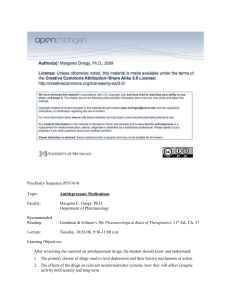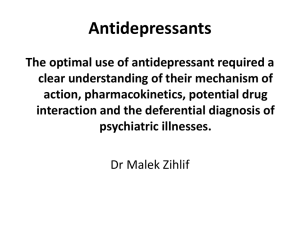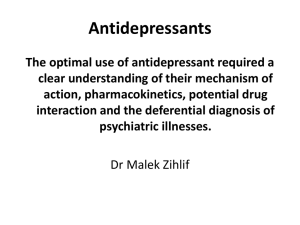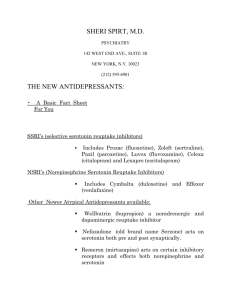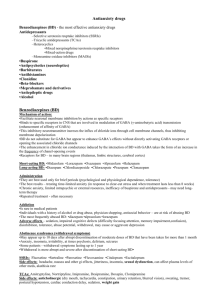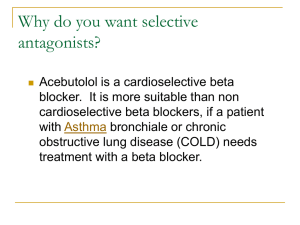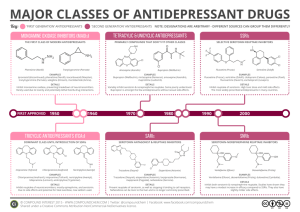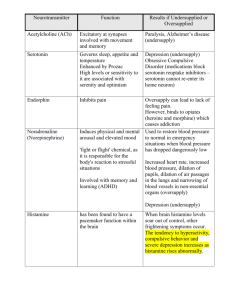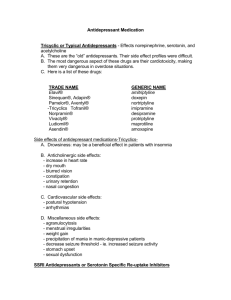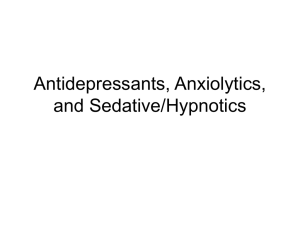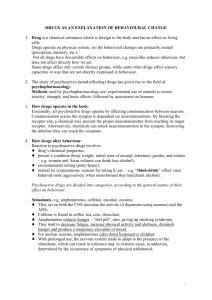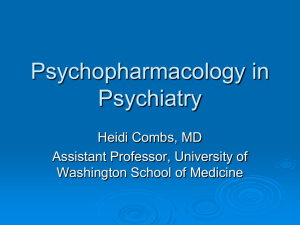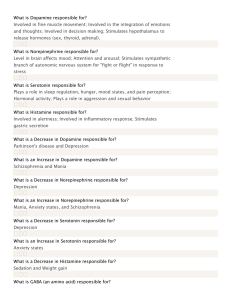A Layman's Guide To Psychotropic Drugs.
advertisement
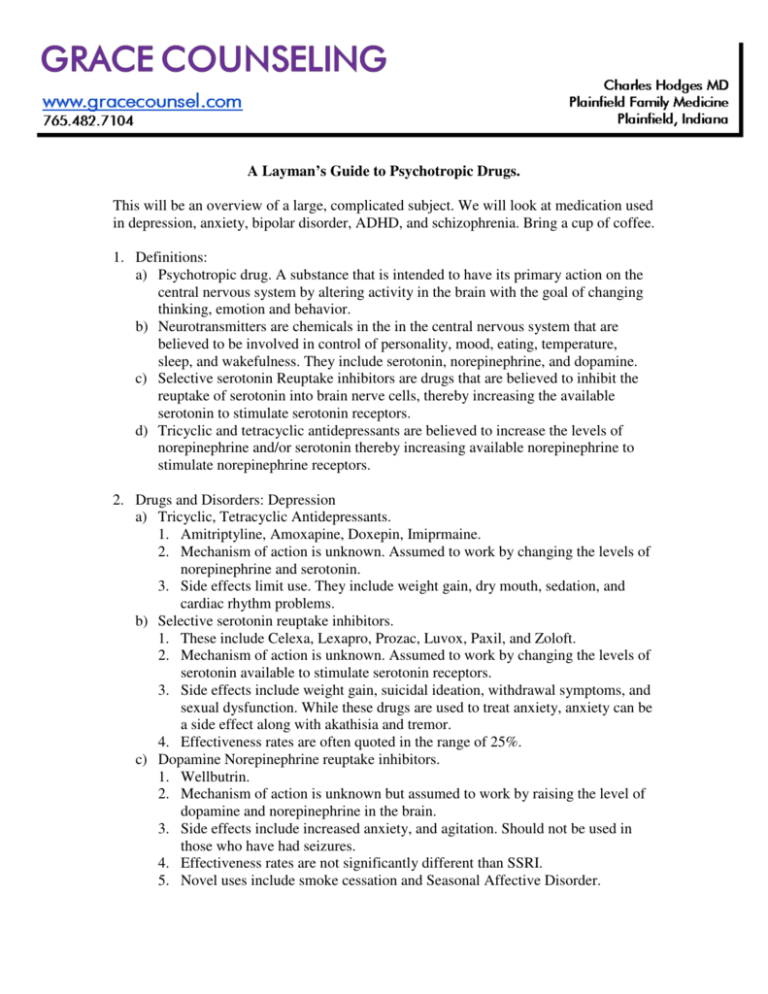
A Layman’s Guide to Psychotropic Drugs. This will be an overview of a large, complicated subject. We will look at medication used in depression, anxiety, bipolar disorder, ADHD, and schizophrenia. Bring a cup of coffee. 1. Definitions: a) Psychotropic drug. A substance that is intended to have its primary action on the central nervous system by altering activity in the brain with the goal of changing thinking, emotion and behavior. b) Neurotransmitters are chemicals in the in the central nervous system that are believed to be involved in control of personality, mood, eating, temperature, sleep, and wakefulness. They include serotonin, norepinephrine, and dopamine. c) Selective serotonin Reuptake inhibitors are drugs that are believed to inhibit the reuptake of serotonin into brain nerve cells, thereby increasing the available serotonin to stimulate serotonin receptors. d) Tricyclic and tetracyclic antidepressants are believed to increase the levels of norepinephrine and/or serotonin thereby increasing available norepinephrine to stimulate norepinephrine receptors. 2. Drugs and Disorders: Depression a) Tricyclic, Tetracyclic Antidepressants. 1. Amitriptyline, Amoxapine, Doxepin, Imiprmaine. 2. Mechanism of action is unknown. Assumed to work by changing the levels of norepinephrine and serotonin. 3. Side effects limit use. They include weight gain, dry mouth, sedation, and cardiac rhythm problems. b) Selective serotonin reuptake inhibitors. 1. These include Celexa, Lexapro, Prozac, Luvox, Paxil, and Zoloft. 2. Mechanism of action is unknown. Assumed to work by changing the levels of serotonin available to stimulate serotonin receptors. 3. Side effects include weight gain, suicidal ideation, withdrawal symptoms, and sexual dysfunction. While these drugs are used to treat anxiety, anxiety can be a side effect along with akathisia and tremor. 4. Effectiveness rates are often quoted in the range of 25%. c) Dopamine Norepinephrine reuptake inhibitors. 1. Wellbutrin. 2. Mechanism of action is unknown but assumed to work by raising the level of dopamine and norepinephrine in the brain. 3. Side effects include increased anxiety, and agitation. Should not be used in those who have had seizures. 4. Effectiveness rates are not significantly different than SSRI. 5. Novel uses include smoke cessation and Seasonal Affective Disorder. Grace Counsel gracecounsel.com d) Selective Serotonin Norepinephrine reuptake inhibitors. 1. Cymbalta, Effexor, Pristiq. 2. Mechanism of action is believed to be the elevation of levels of serotonin and norepinephrine. 3. Side effects are similar to SSRI’s. Withdrawal problems seem to be greater in this class of medicine. 4. Effectiveness similar to SSRI’s 5. Novel uses. Cymbalta is used in chronic pain and does seem to help. e) Serotonin Modulators. 1. Trazodone, Serzone. 2. Mechanism of action unknown as above. 3. Sleepiness for Trazodone and liver failure with Serzone. 4. Effectiveness similar to SSRI’s. 5. Trazodone used for insomnia. f) Monamine Oxidase inhibitors. This class of drugs has significant side effects and is not routinely used today except by psychiatrists. g) Atypical Anti-Psychotics. 1. Abilify. This drug has been FDA approved for use as an add on to the above drugs. 2. Mechanism of action. It is not an antidepressant. It is a major tranquilizer with significant side effects. 3. Side effects include weight gain, Diabetes Mellitus, Tardive Dyskinesia, sedation, Parkinson-like symptoms, cardiac arrhythmias, neuro-malignant syndrome and suicidal ideation. 4. Effectiveness is difficult to assess in that it is used in combination with other drugs. 3. Drugs and Disorders: Anxiety. a) SSRI’s are currently used to treat Anxiety disorders. See above. Buspar is a drug which is related to the SSRI’s and is used for anxiety. b) Benzodiazepine derivatives. These are sedative drugs. 1. Xanax, Valium, Lorazepam, Klonipin and a host of others. 2. These drugs are described as lowering CNS nerve excitability. In sufficient doses they cause unconsciousness and amnesia. 3. Side effects include sedation and addiction. 4. Effectiveness limited by addictive properties. They do calm people down but require regular use and larger doses over time. 4. Drugs and Disorder: ADHD. a) Amphetamine and related drugs. 1. They include Adderal and Adderal XR, (dextro-amphetamine) and Methylphendiate SR, Ritalin, Methylin, Metadate CD and ER, Concerta, focalin XR, the Daytrana patch, Desedrine, and AdderallXR. Lisdexamfetamine or Vivanse. 2 Grace Counsel gracecounsel.com 2. These drugs are central nervous system stimulants and work by causing the release of dopamine and norepinephrine in the brain. 3. Side effects include addiction, seizures, sudden cardiac death, tachycardia, insomnia, Tourette’s syndrome, anger, anxiety, aggression, psychosis, mania, growth retardation. 4. Effectiveness depends on the goal. Studies do not show overall improvement in academic performance. Measurement of “improvement” is completely subjective as is the diagnosis. 5. Addiction and abuse among children is on the rise. As we write more they abuse it more. b) Straterra. 1. This is a non-amphetamine drug for the treatment of ADHD. 2. This drug was developed from a failed antidepressant. It works by inhibiting the reuptake of norepinephrine in the brain. 3. Side effects include liver failure and in a very small number of children, sudden cardiac death. There is reported an increased risk of suicide and aggressive behavior and for psychosis and mania. 4. Effectiveness is in the eye of the beholder. 5. Drugs and disorders: Bipolar Disorder a) Lithium Carbonate. Lithium Citrate was in 7-Up until 1950. 1. A naturally occurring metal originally used to dissolve bladder stones and then found by Dr. John Cade to calm rats, then humans. 2. Mechanism of action is unknown but assumed to work on over active receptors in the cell membranes of neurons. 3. Side effects include renal damage, hypothyroidism, tremors, hair loss, rashes, ataxia, fatigue, and many others. 4. It is effective in the prevention of mania and seems to help with depression in BPD. 5. Off label used in PTSD, aggressive behavior, and conduct disorders in children. b) Atypical antipsychotics. 1. Risperdal, Zyprexa, Seroquel, Geodon, Abilify. 2. The mechanism of action is not known. These drugs are derivatives of the major tranquilizers. 3. Side effects include obesity, diabetes, hyperlipidemia, increased risk of suicide, Tardive Dyskinesia, weight gain, mental slowing, and somnolence. 4. These drugs are effective in controlling mania. They are often used in those labeled bipolar without classic mania. 5. The important problem is that of suicide. Completed suicides are higher for these medicines than in untreated patients. c) Anti-epileptic drugs, AED’s 1. Carbamazepine (Tegretol), Valproate, depakote, lamotrigine (Lamictal). 2. These medicines are anti-seizure drugs that are used as “mood stabilizers”. The mechanism of action is thought to be due to the slowing affect on cell 3 Grace Counsel gracecounsel.com depolarization that reduces seizures. They appear to slow people and their thinking. 3. Side effects are important and include suicide, intellectual slowing, serious sometimes fatal skin disease, and liver dysfunction. 4. They do seem to reduce mania, but at some risk. The best drug may be Lamictal. d) Benzodiazepines. 1. diazepam (valium), lorazepam (ativan), alprazolam (Xanax), clonazepam (klonipin). 2. The drugs are useful to calm those who are manic. They are only useful in the short term and carry a significant problem of addiction. 3. Side effects include sedation, addiction, withdrawal seizures, and withdrawal symptoms. 4. These drugs are useful in the acute treatment of classic mania. 6. Drugs and Disorder: Schizophrenia. a) Atypical anti-psychotics. See BPD above. Add Risperidal which is another atypical antipsychotic. Often used in children to calm them while taking amphetamines. b) Clozapine is placed in the atypical class. It is regaining popularity after recovering from initial serious problems with bone marrow suppression. c) Anti-Psychotic drugs/ major tranquilizers. 1. Older drugs Fluphenazine, and Haldol still in use today. 2. Mechanism of action is not clearly known. They work as major tranquilizers. 3. Side effects are considerable and include dry mouth, flat expression, sedation, mental slowing, weight gain, tardive dyskinesia, Parkinson-like symptoms, tremors, and risk of suicide. 4. These drugs are useful in suppressing the hallucinations and psychosis that occur in schizophrenia. 7. Is it Right or Wrong to take Medicine? a) Judging is a risky business. Matthew 7. b) Paul demands we not judge one another for our opinions. Romans 14. c) Pathology and Scripture separate the facts from opinions. d) Medication is a Romans 14 issue. e) It is the wrong question. f) The right question is, “Does it work and are the side effects worth it?" g) Mercy triumphs over judgment! James 2:12-13. 4
